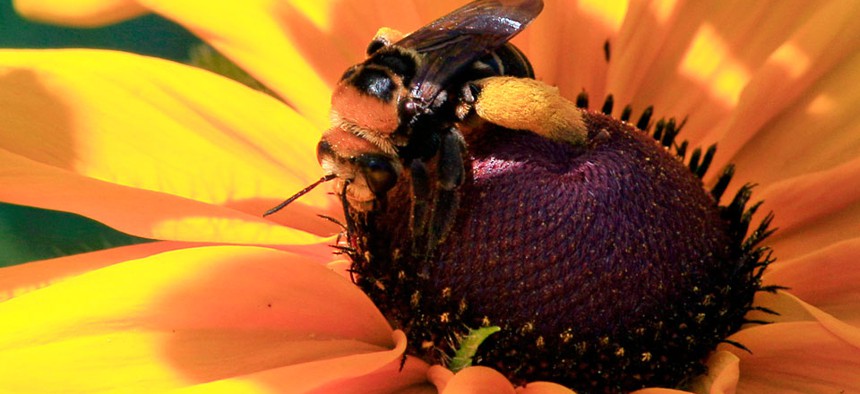
Al Behrman/AP
A New Suspect in Bee Deaths: The U.S. Government
Environmental groups blame U.S. authorities who continue to approve pesticides.
As scientists race to pinpoint the cause of the global collapse of honey bee populations that pollinate a third of the world’s crops, environmental groups have indentified one culprit: US authorities who continue to approve pesticides implicated in the apian apocalypse.
Case in point: The Environmental Protection Agency’s conditional approval in May of sulfoxaflor, a type of agricultural pesticide known as a neonicotinoid. The European Union has banned neonicotinoids for two years in response to scientific studies linking their use to the sudden death of entire beehives, a phenomenon known as Colony Collapse Disorder (CCD). Over the past six years, CCD has wiped out an estimated 10 million beehives worth $2 billion. Bee colonies in the US are so decimated that it takes 60% of the nation’s bee population to pollinate a single crop, California almonds. And that’s not just a local problem; California supplies 80% of the world’s almonds.
Now environmental and food safety groups are seeking to overturn the EPA’s green-lighting of neonicotinoids in a series of lawsuits that for the first time invoke the US Endangered Species Act (ESA) to protect the bees. “EPA inadequately considered, or ignored entirely, sulfoxaflor’s harm to pollinators and the significant costs that harm will impose on the agricultural economy, food security, and natural ecosystems,” attorneys for the nonprofit Center for Food Safety and other groupsargued in a legal brief (PDF) filed in December in litigation aiming to revoke the approval of sulfoxaflor.
Another lawsuit filed in March in federal court in northern California by the Center for Food Safety asks a federal judge to overturn the EPA’s approval of two widely-used neonicotonioid pesticides called clothianidin and thiamethoxam.
Both cases argue that the EPA violated the ESA by failing to adequately consider the impact of the pesticides not just on honey bees but on a host of imperiled wildlife listed as threatened or endangered under federal law—from the Ohlone tiger beetle to the Quino checkerspot butterfly.
The ESA could prove a powerful weapon to wield on behalf of the bees. The law prohibits government agencies from taking any actions that could harm a protected species, requiring them to first consult with the US Fish and Wildlife Service (FWS). In the bee cases, environmental groups cite government records to show that the EPA did neither. “For at least one neonicotinoid insecticide, FWS scientists are on record stating ‘EPA is ignoring their duties with respect to consulting with FWS,’ ” the lawsuit states.
If the courts agree, approval of the pesticides could be at least temporarily revoked while the EPA consults with the wildlife agency and conducts a scientific study of the pesticides’ potential impact on protected species. The EPA maintains it properly approved the pesticides. But in August, the agency acknowledged the potentially deleterious impact of the pesticides when it said it would restrict the use of some neonicotinoids around bees.
The litigation also puts a human face on the bee story. Several of the plaintiffs are longtime beekeepers who have seen their decades-old businesses collapse alongside their beehives.
Colorado beekeeper Tom Theobald, for instance, is losing as much as 60 percent of his bee colonies annually to CCD, while a Florida beekeeper, Bill Rhodes, lost 80 percent of his 9,000 beehives one year.






